|
 ETH Zurich :
Computer Science :
Pervasive Computing :
Distributed Systems :
Research :
Barcode Recognition Demo ETH Zurich :
Computer Science :
Pervasive Computing :
Distributed Systems :
Research :
Barcode Recognition Demo
Barcode Recognition Demo
A Research Demo of the Distributed Systems Group
Automatic
identification technology such as RFID (Radio Frequency Identification)
promises to connect physical objects with virtual representations or
even computational capabilities.
However, even though RFID tags are continuously falling in price, their
widespread
use on consumer items is still several years away, rendering
large-scale experiments
with such an “internet of things” difficult. Much
more ubiquitous are printed
bar codes, yet so far their recognition required either specialized
scanner
equipment, custom-tailored bar codes or costly commercial
licenses – all
equally significant deployment hurdles. We have developed a freely
available
1D bar code recognition and information system that is both lightweight
and fast enough for the use on camera-equipped mobile phones, thus
significantly
lowering the barrier for large-scale, real-world testing of novel
information
and interaction applications based on “connected”
physical objects. We hope
that this “low tech” version of bridging the gap
will allow the community of
researchers, developers and motivated people to quickly develop and try
out
more realistic and widespread applications, and thus gain real-world
experiences
for better jump-starting the future internet of things, today.
In order to illustrate the potential of our BaToo toolkit for the
recognition of EAN-13 barcodes using camera equipped standard mobile
phones, we implemented some prototypical applications. |
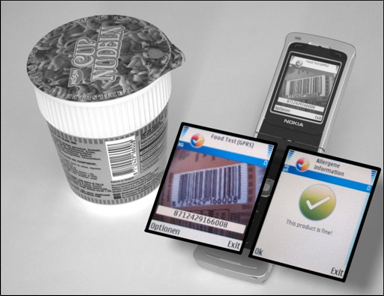
|
Demos
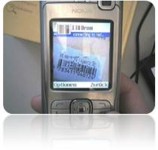 |
Realtime
Recognition
This demo illustrates the realtime recognition of 1D barcodes on
mobile phones. |
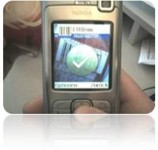 |
Allergy
Assistant Demo
This demo shows the prototypical implementation of a tool for checking
ingredients in nutrition products that could trigger an allergic
reaction. Using a retail goods database such as GS1 one can gain access
to detailed allergen information of individual products, based on their
EAN-13 code. Together with an individual shopper’s allergy
profile, the application is able to warn the user of potential allergic
reactions to an item with. The demo also shows how easy according
applications can become from the user's point of view. |
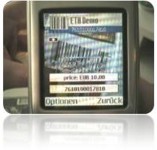 |
Product
Information
This demo illustrates how fast data can be aquired from different
sources. Each time a barcode has been recognized, it will be sent to a
server using the regular mobile phone network. The server will then
query webservices offered by Amazon to obtain the current product's
price and send the information back to the mobile phone, where it will
be displayed. |
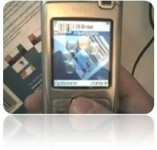 |
Orientation
Detection
This demo shows that additional parameters can be recognized from the
barcode, besides the encoded barcode number. In this case, the relative
orientation of the mobile phone to the code. Such additional parameters
can be used to ease the user interaction. The video shows an
orientation sensitive slider as well as a prototypical menu, in which
the user can select different menu items by rotating the mobile phone. |
More Information
More information is available on the BaToo
Project Page.
This demo was created in February 2006.
See also the following related items:
Selected Publications
See the Publications of the Distributed Systems Group page for a full listing of our publications.
- Robert Adelmann, Marc Langheinrich
Rapid Prototyping Platform for Mobile Phone Based Services on Retail Products.
Demo at the International Symposium on Ubiquitous Computing Systems (UCS 2007), Akihabara, Tokyo, Japan, November 2007
Abstract, BibTeX, Paper (.pdf)
- Robert Adelmann, Marc Langheinrich, Christian Floerkemeier
A Toolkit for Bar-Code-Recognition and -Resolving on Camera Phones – Jump Starting the Internet of Things.
Proceedings of the workshop on Mobile and Embedded Interactive Systems (MEIS'06) at Informatik 2006. GI Lecture Notes in Informatics Series (LNI). Dresden, Germany, October 2006
Abstract, BibTeX, Paper (.pdf)
- Robert Adelmann, Marc Langheinrich, Christian Floerkemeier
Demo Abstract "A Toolkit for Bar-Code-Recognition and -Resolving on Camera Phones – Jump Starting the Internet of Things".
Demo at the Eigth International Conference on Ubiquitious Computing (UbiComp 2006), Orange County, California, USA, September 2006
BibTeX, Paper (.pdf)
Related Student Projects
The following table lists corresponding student projects in our group. Note that some descriptions will be in German.
|




